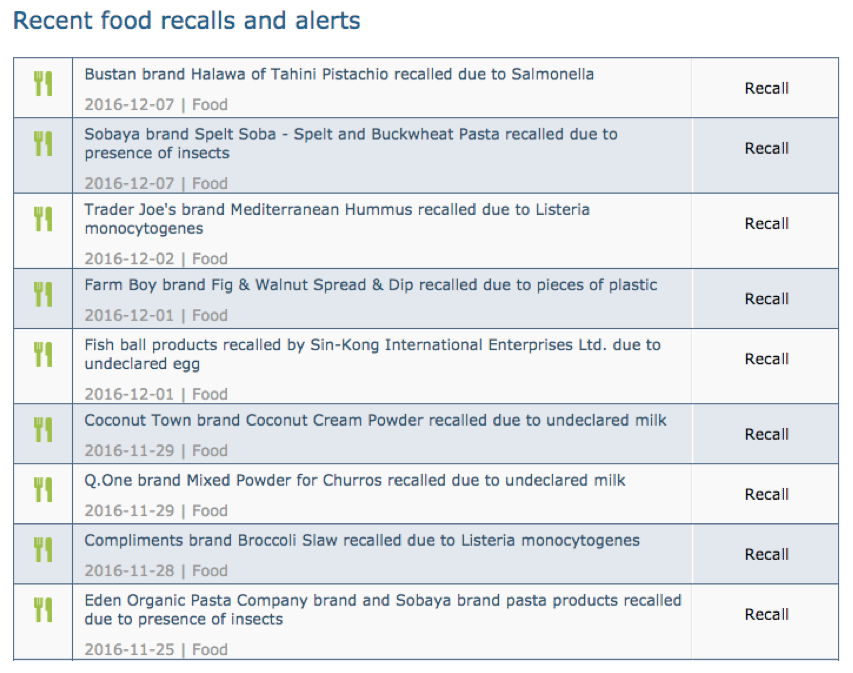Regardless of whether food is produced by conventional means or by organic methods, we expect the food that we consume to be safe. What does food safety mean to you? Are you the type of person that thinks “best before” dates are merely suggestions and that if there’s a little green fuzz on your sour cream it’s an added bonus as an antibiotic, perhaps? How safe is our food in Canada as opposed to other countries? What do we know about the safety of imported foods and the ingredients used to produce them?
All of these questions are important to consumers, particularly given cases of food contamination and zoonotic diseases (those types of diseases that are easily transferred from animals to humans).
A quick scan of the Government of Canada’s Healthy Canadians website shows a long list of recent food recalls and cautionary alerts (Figure 10-7). The full list at the time of writing had 575 pages of recalls going back to 2006!

Figure 10-7: Food recalls and alerts from the Government of Canada. Source: https://recalls-rappels.canada.ca/en Permission: This material has been reproduced in accordance with the University of Saskatchewan interpretation of Sec.30.04 of the Copyright Act.
The list contained all sorts of warnings about contamination that can cause severe illnesses and death including salmonella, listeria, marine biotoxins and E. coli, for example, to other sources of risk resulting from ingredients of unknown origin, mislabelling, banned substances, spoilage and tampering. As is included in the list above, some recalls are due to strange contaminants such as pieces of plastic and insects.
Supply chains are long and often complex, and it is possible to have contamination at many stages. To ensure that our food remains safe and healthy, governments impose rules and regulations, followed up with monitoring and evaluation. However, each action requires additional costs that ultimately trickle down to the consumer.
In Canada, the Canadian Food Inspection Agency (CFIA) is the regulatory authority that oversees the food safety system. It is responsible for inspecting all meat and poultry that is produced domestically, and that is imported. The agency uses different methods to ensure that food producers are in compliance with strict safety standards.
Canada also used the Hazard Analysis Critical Control Point (HACCP), which is recommended by the United Nations, to prevent and minimize food hazards. The system relies on seven principles:
- Principle 1: Hazard analysis/planning to identify and mitigate risk
- Principle 2: Identify critical control points to take action and mitigate risk
- Principle 3: Establish critical limits for food safety
- Principle 4: Establish monitoring procedures to keep an eye on the whole process
- Principle 5: Establish corrective actions to put processes back on track
- Principle 6: Establish verification procedures check if things are being done correctly
- Principle 7: Keep records to document and verify results
Recently, however, new regulations have replaced the seven principles. The new laws can be found on the Justice Laws Website.
All these processes are designed to keep us safe and healthy. When things do go wrong, it’s possible for consumers to contact the CFIA to make reports and to check for recalls.
What do you think – is our food safe?
The possible answers to the whiteboard question are, yes, no, and I don’t know. So, maybe I didn’t ask the right question… How do we answer the question above using an economic mindset? Look what happens when I ask the question from an economic perspective: Is our food safe enough? Asking a question at the margin can help us come up with a better answer.
We will certainly never reach food safety levels that are 100% and we likely don’t want to. The reason is the same as why we will never reach a point in society where pollution is zero. It’s not feasible and it’s not desirable. Of course, we want safe food and clean environments, but what do we have to give up to achieve that?
Back to the question. How would we determine whether food is safe enough or if we want to increase safety measures? We would start by looking at the costs of improving food safety. That would likely entail more inspections, more record keeping and tracking, improving traceability through the supply chain, etc. This of course comes at a cost that will lead to increased prices in the supermarket. Are we as a society willing to pay more for our food? Is it worth it to us, or is our food safe enough? We would also have to determine how much safer our food would be. Perhaps we reduce recalls by 5%. Is that good value? Is it worth it?
You can choose to debate this topic by answer some of the questions I’ve posed throughout the module. For a very good overview of the increased demand for food safety and effects on producers and consumers, see Valeeva et al. 2004.
